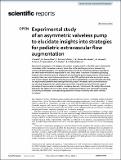| dc.contributor.author | Anatol, J. | |
| dc.contributor.author | García-Díaz, M. | |
| dc.contributor.author | Barrios-Collado, C. | |
| dc.contributor.author | Moneo-Fernández, J. A. | |
| dc.contributor.author | Horvath, M. | |
| dc.contributor.author | Parra, T. | |
| dc.contributor.author | Castro-Ruiz, F. | |
| dc.contributor.author | Roche, E. T. | |
| dc.contributor.author | Sierra-Pallares, J. | |
| dc.date.accessioned | 2024-04-10T16:40:23Z | |
| dc.date.available | 2024-04-10T16:40:23Z | |
| dc.date.issued | 2022-12-22 | |
| dc.identifier.issn | 2045-2322 | |
| dc.identifier.uri | https://hdl.handle.net/1721.1/154108 | |
| dc.description.abstract | Asymmetric pumping is a sub-category of valveless pumping in which a flexible tube is rhythmically compressed in the transverse symmetry plane. Due to the resulting asymmetry between the suction and discharge pipes, a net pumping head is achieved. Asymmetric pumping is regarded as one of the main mechanisms responsible for the Liebau effect in addition to impedance pumping. However, there remains a paucity of research surrounding the governing parameters of asymmetric pumping. Here, we conducted an experimental study of the performance of an asymmetric pump, with an aim to assess its potential for extravascular flow augmentation. A custom flexible latex tube and experimental platform were developed for this purpose. We tested various tube thicknesses and pinching frequencies. Our results demonstrate that the performance is within the range of physiological requirements for pediatric circulatory devices (~ 1 L/min and < 30 mmHg). We conclude that due to the absence of reverse flow and its mechanical simplicity, pure asymmetric pumping is promising for selected cardiovascular applications with less complexity than other valveless techniques. | en_US |
| dc.language.iso | en | |
| dc.publisher | Springer Science and Business Media LLC | en_US |
| dc.relation.isversionof | 10.1038/s41598-022-26524-0 | en_US |
| dc.rights | Creative Commons Attribution | en_US |
| dc.rights.uri | https://creativecommons.org/licenses/by/4.0/ | en_US |
| dc.source | Springer Science and Business Media LLC | en_US |
| dc.subject | Multidisciplinary | en_US |
| dc.title | Experimental study of an asymmetric valveless pump to elucidate insights into strategies for pediatric extravascular flow augmentation | en_US |
| dc.type | Article | en_US |
| dc.identifier.citation | Anatol, J., García-Díaz, M., Barrios-Collado, C. et al. Experimental study of an asymmetric valveless pump to elucidate insights into strategies for pediatric extravascular flow augmentation. Sci Rep 12, 22165 (2022). | en_US |
| dc.contributor.department | Massachusetts Institute of Technology. Institute for Medical Engineering & Science | |
| dc.contributor.department | Massachusetts Institute of Technology. Department of Mechanical Engineering | |
| dc.relation.journal | Scientific Reports | en_US |
| dc.eprint.version | Final published version | en_US |
| dc.type.uri | http://purl.org/eprint/type/JournalArticle | en_US |
| eprint.status | http://purl.org/eprint/status/PeerReviewed | en_US |
| dc.date.updated | 2024-04-10T16:31:05Z | |
| dspace.orderedauthors | Anatol, J; García-Díaz, M; Barrios-Collado, C; Moneo-Fernández, JA; Horvath, M; Parra, T; Castro-Ruiz, F; Roche, ET; Sierra-Pallares, J | en_US |
| dspace.date.submission | 2024-04-10T16:31:09Z | |
| mit.journal.volume | 12 | en_US |
| mit.journal.issue | 1 | en_US |
| mit.license | PUBLISHER_CC | |
| mit.metadata.status | Authority Work and Publication Information Needed | en_US |
